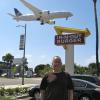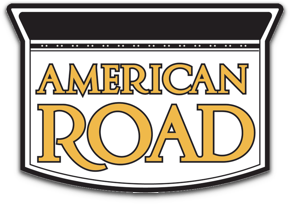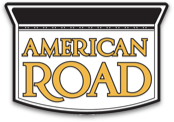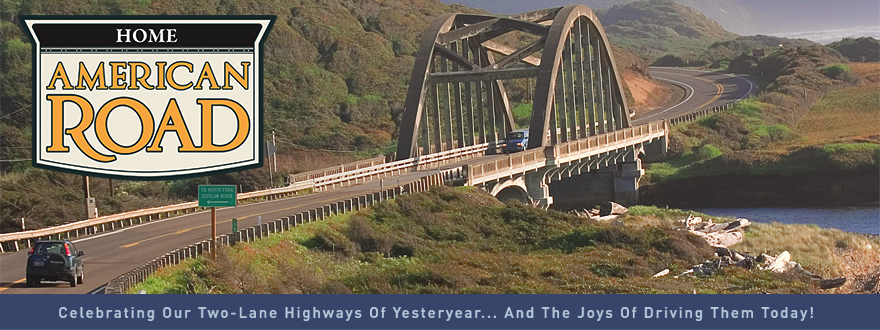-
Posts
328 -
Joined
-
Last visited
-
Days Won
4
Content Type
Profiles
Forums
Gallery
Blogs
Calendar
Everything posted by mga707
-

1914 Padre Canyon Bridge
mga707 replied to roadhound's topic in National Old Trails Road / Santa Fe Trail / U.S. 66
Wow! (again!) VERY nice! Another old road site I've yet to see in my own state. One interesting factoid is that the current I-40 bridge over the canyon has been in use at least twice as long as either of the bridges before it (1914 and 1937). I'm not certain of the build date of that particular section of 40, but the stretch between Flagstaff and Winslow was one of the earlier parts constructed in Arizona. I'd guess early to mid-1960s. I know that that section of 40 existed in 1968, as I rode on it in that year--wasn't yet old enough to drive! Driuves home the point that many of our Interstates are getting rather old! -

Essex Airfield
mga707 replied to roadhound's topic in National Old Trails Road / Santa Fe Trail / U.S. 66
There is still a similar such airstrip near Desert Center, between Indio and Blythe along I-10/old US 80. In the VERY early days of commercial aviation--late '20s/early '30s--it was often used as a "potty break" on the LA-Phoenix run, as the early airliners of the day such as the Fokker VII used by Standard Airlines/Western Air Express (in 1930 this route was sold to American Airways--now Airlines) did not have on on-board lavatory like the slightly later Ford Tri-Motor did. -

Essex Airfield
mga707 replied to roadhound's topic in National Old Trails Road / Santa Fe Trail / U.S. 66
All I can say is "Wow"! I love this stuff, especially with my love of aviation history as well as old road travel. I knew that Patton's tanks had trained in this area, much of which is now part of the Mojave National Preserve (north of I-40), but was unaware of the Essex airfield. 5000-ft. steel-matted runways would certainly have been more than adequate for any aircraft in the Army Air Corps' 1942 inventory (pre-B-29, which would have needed a bit more runway length). I can imagine C-47s (military DC-3s) buzzing in and out of there with men and supplies for Patton's army! -
I too do not care for alphanumeric auto badging, nor do I particularily care for renaming of models. That said, I give Ford credit for the Mustang, currently the longest-running continuous nameplate sold in the US. Every model year since it's mid-year introduction in 1964. This does not count names like Impala, which first debuted in 1958 but has not run continuously in every model year since. No Chevys were badged "Impala" from 1986 through 1992, and again from 1997-99. The Mustang took the longest-used name title in 2009, after Pontiac dropped the Grand Prix nameplate that had appeared every model year since 1962. If one counts light trucks, however, then the Suburban is by far the longest-lived nameplate, having been used by Chevrolet/GMC since the mid-1930s!
-
One more birthday wish to add to those above! Denny is exactly 11 years ahead of me.
-

Money Saving Ideas: So We Can Still Enjoy Our Road Trips
mga707 replied to beckyrepp's topic in Polls/Surveys
Amen, brother Dave! I've twice stayed at the 5-star/5-diamond Camelback Inn resort in Paradise Valley (Scottsdale) AZ in July for right around $100/night---in July! Right now the "high season" rates at said property are probably three to four times that. ...and with cold A/C in your 'casita' and the pools cool and wet, who cares that the usual high/low temps that time of year are around 110/85 degrees! -
Well, for me it was the fact that SD and ND were the only two states I was lacking, and my travel companion had not been to either of them, nor to MT and WY, so we flew to Denver, rented a car, and did a big northern plains loop. Like you said, ND has it's charms, as does it's more-visited southern neighbor. And I guess right now it's the most economically healthy state in the country, with the oil boom up there. As far as Hawai'i, I've been there three times. My Delta pilot friend used to live on Maui, so for two of my visits I had a place to stay, which was really nice (and money-saving!). I think my favorite island is Moloka'i, because it is so un-touristy and totally "laid back" the native way! I still need to visit Lana'i, so I have a reason for yet another trip, although my friends have since departed Maui for Indiana. I heartily recommend Hawaiian Airlines for both inter-island and mainland to/from Hawai'i. They treat you right.
-
Hello, Charlie! Welcome! I'm a "50 stater", since 2006. North Dakota was my 50th. Have overnighted in only 47, though. Alabama, Mississippi, and New Hampshire have so far just been "drive throughs".
-
Excellent photos--thanks! I was just in central Indiana last week (Mooresville) on my semi-yearly visit, but unfortunately this year I did not have any extra time to do National Road exploring.
-
Now that is a cool road! Even today, the route through the pass on I-25 is one of the better stretches of Interstate in the Southwest. The postcards' writer exaggerated just a bit: The top of the pass is a little over 7800 feet in elevation. Aside: There's an excellent little non-chain motel right in "Rat-town" called the Raton Inn. Clean and quite nice.
-
Love the '49 "Aeroback" Chevy--but those two kids look like trouble! No personal experiences on these two roads, although they look like fun drives, but if one wants to see what the "P to P Highway" (SR 74) looked like nearly 50 years ago, check out the classic comedy "It's a Mad, Mad, Mad, Mad World". The opening sequence--in which Jimmy Durante 'kicks the bucket'--was shot on one of the winding stretches of said highway. The film was released for the summer of '63, so the sequence was probably shot in summer/fall '62. I think the closest I've been to a 'control road' is the Pikes Peak Highway, where one must stop at a 'control' point on the way down so that the attendant can check to make sure you aren't overheating your brakes! Locally (Tucson AZ), the unpaved road up the back (north) side of the Santa Catalina Mountains from Oracle to Summerhaven is still called the Mount Lemmon Control Road, and as it was the original route up to the top of Mt. Lemmon, predating the paved Mt. Lemmon Highway that winds up the south slope of the range by quite a few decades, I'm guessing it was also once 'controlled' in the same manner.
-
Your US 20 is my US 80! Welcome!
-
Been there, done that! My Holbrook Wigwam visit was on January 1/2, back in the mid-90s. My experience was amazingly similar to BRM's: Space heaters, freezing bathroom, no one else there but us, room basic but clean. Followed up the next day by a rather bracing visit to Petrified Forest NP with an arctic wind howling (and no trees other than the fossilized stone kind to block it)! A fun trip nonetheless.
-
Yes, August in Seaside is busy on the weekend! Especially the last Saturday of the month, as that is the date of the annual Mt. Hood to the coast relay race, which ends in Seaside. Unfortunately, that happened to be the day we visited last August!. No P'n'P for us, as there was about an hour wait for a table--ditto for the Astoria location. Both towns were hopping--I'm sure the merchants love the relay race weekend!
-
In terms of 'roadie' experiences, it was definitely the drive on the historic Columbia River Highway in Oregon (original US30). That lived up to it's reputation! As far a 2012, I'm hoping to finally do at least a portion of the Natchez Trace this coming summer. I'm planning to be in Memphis in late July, so why not. Probably combine the Trace with part of Dylan's famous "Highway 61". Visited, not "Revisited".
-
Interesting maps to be sure. The caption under the first map says that it was created in 1876. This seems to be about right as the "surveyed route of the Southern Pacific Railroad" is shown and the SPRR reached Tucson in 1881 or 82, IIRC.
-
If you're ever in Winslow and looking for another historic site to see, check out the Winslow airport terminal building off of AZ87 south of town. It dates from 1928 and was designed by Charles Lindbergh when he was consulting for Transcontinental Air Transport (TAT), the main predecessor company to TWA. It has really not been altered much if at all, and the adjacent hangar is from the same period. Lindbergh laid out all of the stops on TAT's Ford Tri-Motor transcontinental route, which was originally in conjunction with two railroads. Fly by day, rails by night, coast to coast in three days! There was a similar Lindbergh-designed terminal in Kingman, another original stop on the route, but that one was demolished about 20-25 years ago, sadly. The Kingman stop only lasted a few years, being replaced with Boulder City (NV) once that town came to life circa-1930 for the construction of Boulder (Hoover) Dam. TWA continued to serve Winslow (INS) well into the 1950s with DC-3s, and the original Frontier continued the service right up until deregulation in 1979. Since that time INS has struggled to maintain any scheduled air service as it is not an Essential Air Service (EAS) city. Of course, having a much bigger town (Flagstaff) right down the road is the main problem. Most people don't realize that Winslow used to be the 'hub' of northern Arizona, and was larger than Flagstaff right up through the 1940 census. Since that date, Flag's population has mushroomed from about 5000 to well over 50,000 (plus the NAU student population), while Winslow still has about the same 6000-7000 people that it had 70 years ago. OK, end of Arizona aviation history lesson!
-
That IS indeed a cool map! And correct you are on the La Posada. Where I've slept!
-
From what you say, and from what I have gleaned from the University of Arizona's road map archives, I believe you are correct in that the alignment was probably moved pre-66, back in the Old Trails Road era of the teens and early 20s. From what I recall, the U of A's map collection has the same two maps that you have, the 1913 map and the 1926 map which was the first to show US route numbers, and on which 66 is called 60. Unfortunately, i don't recall them having any from between those two dates. The oldest Arizona road map that I personally have is from 1953, so no help there. The U of A does have a nice collection, though.
-
Really enjoyed the bridge photos! I left you a comment on the page regarding the Painted Desert bridge site. Excellent work!
-
Yes, Irene put a giant monkey wrench into a lot of vacation plans. I was at the Airliners convention in Portland (OR), and as soon as it became clear that Irene had the New York metro area in her sights, the Big Apple area folks all started to bail early, knowing they had to get home before carriers started pulling planes out of the three NY airports (six airports, if you count Islip, White Plains, and Stewart/Newburgh) to get them out of (potential) harm's way. What made it worse was that a lot of them (the airline employees or retirees) were traveling non-rev, which means that they are flying space available only--no guaranteed seats. A friend of mine who works for US Airways at LGA was able to get back in time to batten down his Bronx apartment (tape up the windows, get provisioned, etc.), but he had to take the 'scenic route' through two of US's three hubs, Phoenix AND Charlotte, on the trip from PDX to LGA! Luckily, Irene turned out to be not as bad as predicted in the city and surrounding area. It was much worse, flooding-wise, farther north, in far upstate NY and VT.
-
You're quite welcome. I see from looking at your old AZ map site that my fuzzy memory was wrong in one respect: The 1930's "Temporary 60" did NOT turn westward upon reaching what is now still AZ 73, but rather stayed to the east and went through Whiteriver and McNary on it's way to Springerville. I had forgotten that the stretch of 60 between Show Low and Springerville/Eagar, via Vernon, was also a later construction. My memory was based upon several visits to the map collection at the University of Arizona library. They have an extensive Arizona (and Tucson) map collection in their basement map room. Well worth a visit. A digression: One thing I love about the 1930s Arizona state highway maps is that for a number of years the borders of them were decorated with what are now known as swastickas. Yes, the infamous Nazi logo, back when it was still an innocent Navajo symbol. You see, those dastardly National Socialists in Germany took the native American symbol, turned it around 180 degrees, and made it into something evil. The Navajo had used it for many centuries before the Nazi's swiped it. I've also thought of one other area where there is an old 60 alignment, in my neighboring state to the east, New Mexico. Some years back we took one of many weekend trips to the "Land of Enchantment", and one of our stops was the Very Large Array radio telescope site west of Socorro. If you've seen the movie "Contact" you know the place: Dozens of radio telescopes radiating out in three lines from a central point. The visitor center and site headquarters is located a mile or two south of present-day 60, and I distinctly remember that the access road to the visitor center and the 'scopes was a road marked as "Old Highway 60". I also seem to remember that old 60 continued on to the west past the VLA site, still well south of current 60, but I don't know if the full segment is drivable or not. Anyway, there's another one for you, in yet a third state no less!
-
I see you are already familiar with the old alignments on the mountainous stretch between Superior and Globe from the above post. I'll also assume that you know that the original 60 alignment through metro Phoenix/Tempe/Mesa/Apache Junction was not via the freeways as it is currently, but was (W to E) Grand Avenue/Van Buren Road/Mill Avenue (crossing the Salt River over two adjacent bridges--The older bridge is now closed to vehicles but is still walkable)/Apache Boulevard-Main Street-Apache Trail (all the same road but with name changes as it goes from Tempe to Mesa to Apache Junction)/Old West Highway (formerly Florence Highway). An interesting factoid about this stretch of 60, extending eastward to Florence Junction, is that for several decades (1930s to 1960s) it was quadruple-designated as US/60/70/80/89. I cannot think of any other stretch of US highway that had four concurrent designators over such an extended stretch, with three of the four being 'major' zero-digit routes, and the fourth one a border-to-border N-S route (89). The 60 segment from Globe NE to Show Low is interesting, not so much for old alignments (there are some of those, but they are all close to the present alignment on either side), but for the fact that is was the last stretch of 60 to be completed in Arizona, not being fully constructed until circa-1940. The Salt River Canyon certainly provided construction challenges. If one looks on Arizona state highway maps from the 1930s, a "Temporary US 60" is shown, over the following routing: US 70 from Globe to San Carlos, including what is now Apache Route 6 (Old San Carlos Road) from Cutter to San Carlos; thence from San Carlos to what is now AZ State Route 73 via Apache Routes 10, 4, and 9; thence via 73 to Carrizo Junction and back onto what is still US 60 to Show Low. Most of these reservation roads between San Carlos and AZ 73 are unpaved even today, and must have been a truly wild and harrowing adventure in the 1930s! The only other major old 60 alignment that I am aware of in eastern Arizona is a drivable stretch east of Springerville that goes first north of and then south of the present alignment and is signed as Old Highway 60. Hope I have been of help and interest.
-
Thanks. Glad to help. You only asked about old California alignments so I did not mention it, but just across the Colorado River in my state (Arizona), there are two other old 60/70 alignments. The old road veers north from I-10 immediately east of the bridge and goes away from the present alignment for about 6 1/2 miles, through the now-abandoned original settlement of Ehrenberg, before eventually rejoining the current road. What is current called Ehrenberg is the commercial area around Exit 1 and is several miles from the original townsite. You can exit 10 at the first Arizona exit (Exit 1) and rejoin it at the second exit (Exit 5) to travel on this old alignment. Another old alignment is drivable between exits 11 and 17. Now called Dome Rock Road, this section is to the south of the present Interstate alignment.



